Science of Performance: Hand Entry, Part II
By G. John Mullen of SwimmingScience.net and CenterofOptimalRestoration.com, Swimming World correspondent
Note: In case you missed it, here's Part I.
SANTA CLARA, California, November 8.YOU'd be hard-pressed to find a term used more often to describe elite swimmers than "feel." "Feel" has multiple definitions dependent on the person talking, but ask any top coach and I guarantee "feel" will come up when discussing top-tier swimmers. This term isn't even isolated to one stroke or one distance, but encompasses swimming, yet the definition is variable and hazy. "Feel" is not just how much water moved, or hand position, or even a constant entity. To that end, it's a variable term every swimmer, age-group, Olympic, or Masters can improve to reach their optimal potential.
Unfortunately, as with any topic with multiple definitions, describing and obtaining a pristine understanding is impossible. This article will begin to tackle the subject of "feel" about proper hand orientation and obtaining "feel" in swimming. Some may think "feel" is something people simply possess and doesn't improve with training/coaching. If you are in this camp, I feel you have lost all faith in coaching and have predetermined which athletes will succeed. This is sacrilegious in coaching as trying to teach any essential aspect to someone is essential, so blaming lack of understanding on genetics is a cop out.
With this in mind, I'm going to show the entire, "normal", high elbow freestyle hand entry and initial catch in still frames. After this, I will show videos and delve into some of the common errors.
As discussed in part I, there is a myth that one hand orientation is right for every swimmer. This article is not to feed into this myth, but to discuss the commonalities I've seen with elite swimmers. Remember trial and error and adjusting for anthropomorphic and physiological differences is mandatory.
First, let's tackle the goals of the entry and initial catch phases:
Entry:
The goal of this phase is to minimize resistance when the hand hits the water and setting the swimmer up for an optimal initial catch.
Initial Catch:
Transitioning from entry to the initial catch is a complex movement with the goal of achieving an early vertical forearm (EVF) as quick as possible to maximize the distance of the catch.
Step 1
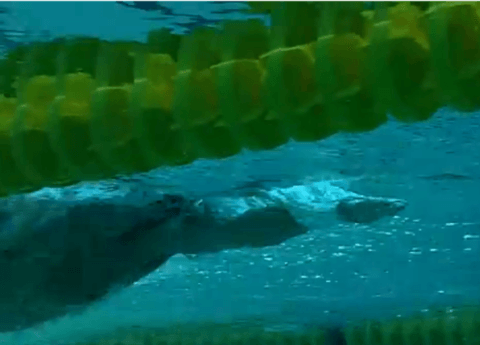
The shoulder is flexed to approximately 160 degrees with nearly 60 degrees of elbow flexion to promote the finger first entry. Then, the hand enters with slight pronation (thumb first) to promote a clean, small hole of entry. The fingers should be slightly spread apart and performing isometric finger flexion encouraging a steady, firm hand. The thumb is also separated from the hand to maximize surface area.
Step 2
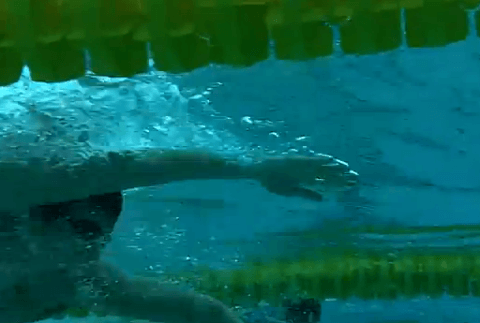
Next, the elbow extends directly in front of the shoulder as the elbow supinates to orient the hand parallel to the bottom of the pool. The fingers remain in the same position not letting the water move the hand.
Step 3
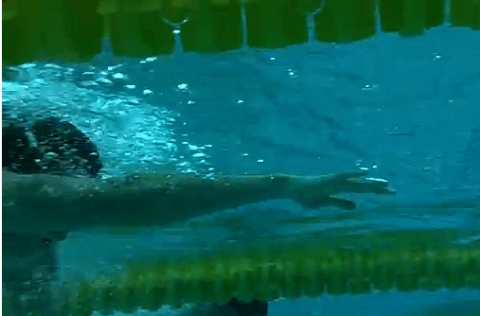
The elbow fully extends as the fingers and thumb spread a bit more increasing the size of the hand in preparation for the catch. Side-bar, the finger spread is dependent on the speed of the hand through the water. The faster the hand moves through the catch, the larger the distance the fingers can have between each other and still be recognized as one unit.
Step 4
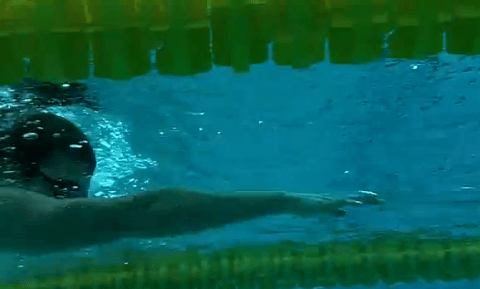
Next, the wrist begins to slightly press down (flexing) as the shoulder full flexes, approaching 180 degrees with simultaneous forearm supination. This maximally elongates the arm putting the body in a "half streamline" position.
Step 5
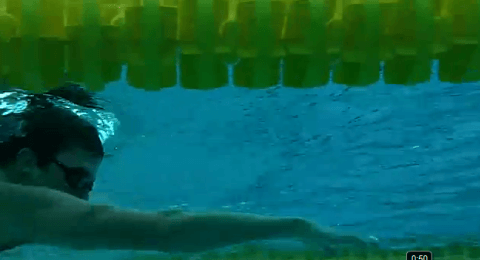
The wrist then actively flexes in combination of shoulder internal rotation, preparing for an early vertical forearm (EVF). This elbow, hand, fingers and thumb remain stationary during this phase.
Step 6
Initial Catch
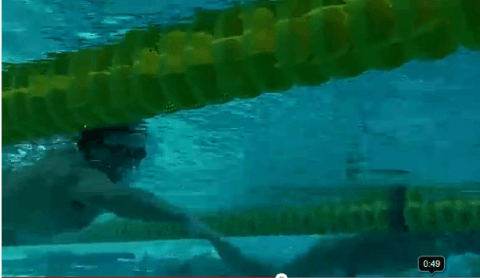
Early Vertical Forearm
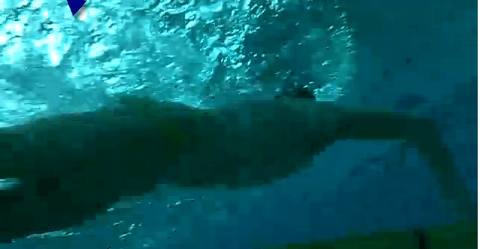
Lastly, the shoulder fully internally rotates as the elbow begins flexing to achieve an early vertical forearm. The shoulder has undergone no shoulder extension in this phase to maximize the distance to grab water and pull oneself as far as possible.
Freestyle Flaws
These errors are intentionally over-exaggerated, but they are scattered across pools along the Nation. Some of these errors will impede velocity, decrease potential force production or increase one's risk for injury. Let's get into the common errors and a few ways to correct the freestyle flaws.
Thumbs Down-"I'm not happy with this practice, two thumbs way down"
This is the swimmer who attempts to achieve a thumb's first entry, but instead of rotating from their forearm they internally rotate their shoulder. This rotation wraps the rotator cuff muscles potentially rubbing the rotator cuff tendons, increasing ones risk for injury.
This will impose a large out sweep, to prevent the hand from crossing over the body, delaying the start of the catch. The difference between forearm pronation and shoulder internal rotation may look minimal, but can make a big difference. Make sure you and your swimmers know the difference between the two!
Thumbs Up-"I'm doing awesome, thumbs up for me"
This flaw is rarer than the thumbs down cousin, but is extremely inefficient. It prevents setting up the ideal catch and increases the amount of water pushed toward midline. It is mandatory to orient the hand towards the floor of the pool during the entry and glide, then transition from horizontal to vertical in the initial catch to create lift. Instruct a firm hand throughout the pulling phase, no sloppy hands allowed!
Arm Slapper-"Take that water!"
In freestyle minimal sound should be heard. Sound is a form of energy and energy is wasted if the swimmer smacks the water! Often times these swimmers appear sun burnt, but their forearms are red due to water abuse, not UV rays. This high drag stroke is a confused form of straight-arm recovery and does not enhance swimming speed. Instruct the swimmer to have their hand enter first, followed by the rest of their arm. Having the whole arm enter through one hole will decrease drag and increase speed!
Hitchhiker-"I need a ride, can I grab onto anyone's feet?"
As discussed in part I, having distal thumb extension can increase drag and eddy currents. This occurs when the swimmer tries to maximally extend their fingers to increase their surface area for the catch. To break this habit, the swimmer will have to actively flex the distal part of their thumb. This will be a long process, but can make a big difference in drag. Instruct them to hold their thumb firm and STRAIGHT!
Princess Waver-"Hello my disciples at the bottom of the pool"
Shaky or wavy hands are a common flaw in freestylers during the entry and glide. Many will say this athlete has poor "feel" and should take up croquet. From my experience waving is due to poor strength to actively press on the water to control the water or from poor shoulder stability. As the hand enters the water, the hand must isometricly flex to prevent excessive movement. This isometric contraction needs to hold the wrist, fingers and thumb in their optimal position.
If the shoulder has poor proximal stability, then the shoulder undergoes slight movements traveling through the entire arm. Just like a building with poor foundation, the top of the building will shake more than the bottom during an earthquake. This can increase the swimmer's risk for injury and increase drag. Cue them to hold their shoulder blade down and back to stabilize this proximal joint to prevent distal movement.
Kitten Mittens-"Does your cat make too much noise?"
To maximize surface area the fingers will slightly separate and flex to achieve a "bear claw" position. This will have a rounded appearance to maximize the catch. Kitten mittens is when the hand is held flat and glued together in a microscopic position, not allowing the athlete to grab water. These swimmers generally try to have soft hands and are gentle creatures. Be aggressive and move faster!
Water Petting-"Good water, you're my best friend"
This athlete has difficulties keeping a firm hand during the initial catch. During the initial catch, their hand with extend, instead of holding isometric wrist flexion. This petting motion will lose all the water they are trying to grab, forcing them to start the whole catch over, what a waste! This flaw is from poor forearm and grip strength! Make it easier on yourself, keep your wrist firm, grab, move and control the water. It may be harder at first, but it will pay off, trust me.
"Proper" Hand Orientation
Conclusion
That wraps up the analysis of the typical entry and initial catch. Fortunately (or unfortunately, depending on your view), we've got literally thousands of variations of the "ideal" entry and initial catch. Some may put one at a higher risk for injury or impede velocity, while others optimize swimming potential. Luckily, there are different variations of these phases to be optimal for swimmers of different needs. In part III, we'll cover several of them.
Dr. G. John Mullen is a Doctor of Physical Therapy and a Certified Strength and Conditioning Specialist. At USC, he was a clinical research assistant at USC performing research on adolescent diabetes, lung adaptations to swimming, and swimming biomechanics. G. John has been featured in Swimming World Magazine, Swimmer Magazine, and the International Society of Swim Coaches Journal. He is currently the strength and conditioning coach at Santa Clara Swim Club, owner of the Center of Optimal Restoration and creator of Swimming Science.



